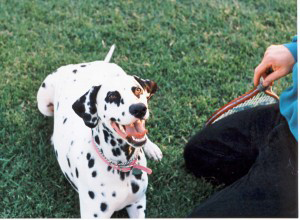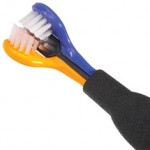
February is Pet Dental Health Month. The American Veterinary Dental Society estimates that 80 percent of dogs and 70 percent of cats show signs of oral disease by age three!
What if you had to go without brushing your teeth for a week? What if you had to stop for a year? Unthinkable, right? Yet many pet owners neglect the dental health of their cats and dogs.
Not only does this make their breath bad and their smile yellow, it can lead to periodontal disease or gingivitis. Pets can get swollen and bleeding gums and painful cavities. I know about this personally. Once our cat, Brownie, stated losing weight. I noticed she was not eating as much as usual and wondered if she was sick. When I took her in, the veterinarian showed me that the problem was her teeth: they had gotten so bad that it hurt to eat!
Your your dog or cat may be suffering, too, but it has no way to tell you!
Poor dental care can even lead to kidney, liver, or heart disease.
Yes, it is hard to get a cat or dog to sit still and endure teeth brushing, but it can be done.
Here are some tips:
Buy pet toothpaste. Look for a pet toothpaste with enzymes. It comes in different flavors, try poultry. Pet tooth paste is safe for pets to swallow and they like the taste. Never use toothpaste made for humans, which can make a pet sick.
You can buy the toothpaste online or at a retail pet store. It should run you $5 to $6. If you buy online, look for a coupon code at check out. Open another window and do a search for the name of the online store along with the words “coupon code.” You can also try a search with the name of the store and”free shipping.” You may find a code to save you some money.
Buy a pet toothbrush. Some are specially shaped and have two sides so you can brush front and back at once. All have soft bristles. Pet toothbrushes run from $3 to $10. You can even get electric ones. You can also use just a child’s soft toothbrush. You can get those at the dollar store to save money.
If you are just starting, you may want to consider buying a kit that has both the toothpaste and the toothbrush. I have some links below to buy through Amazon.
Let your dog or cat try the taste. Massage the gums with your finger. Once the animal starts accepting or even looking forward to this new ritual, introduce a toothbrush.
Periodontal disease usually affects the upper, back teeth first and worst so make sure you cover those areas. Try to clean near the gum, just like you do when you do your own teeth.
For a cat or a small dog, hold it in your lap. For a larger dog, have a leash on.
Accept that a bit of chewing or mouthing in inevitable. Do not get frustrated and give up. It may take several weeks for the two of you to get the process down.
Do the best you can. Even if you cannot brush every tooth completely, the enzymes in the toothpaste will help clean the teeth, and some brushing is better than none. You may be able to do a btter job as you get both get used to it.
Establish a ritual, a time of day when you always do it so you do not forget. Follow up with praise and maybe even a treat. Give yourself a treat, too, so you look forward to the ritual. Do it every day.
Dental chews, rawhide, dental bones and other healthy products can help, but do not think they can replace brushing.
If your pet already has signs of periodontal disease, you will need a professional cleaning by your veterinarian. This is expensive because it requires anesthesia. Your pet may require a professional cleaning less frequently if you maintain a routine of brushing, so you save money.
Pat yourself on the back for taking good care of your pet despite your busy schedule. And enjoy a beautiful smile on your pet.
If you love pets, please pass the word on about brushing teeth. Let me know if you have other tips.
A condensed version of this article can be found on eHow.
I found a couple good pet toothbrush / toothpaste kits on Amazon and the links are below.

